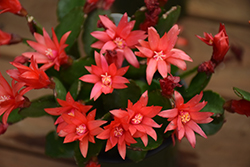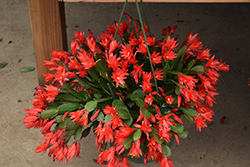Fri & Sat 8am - 8pm
Sun 8am - 7pm
Anytown, USA 12345
fax: 261.787.0463
e-mail: info@successgc.com


Plant Finder

Height: 10 inches
Spread: 24 inches
Sunlight:
![]()
![]()
Hardiness Zone: 10a
Other Names: Hatiora gaertneri, Schlumbergera gaertneri
Description:
A stunning garden, container or basket plant that produces gorgeous blooms in a variety of colors, in winter or early spring; easy to care for; locate in a bright area
Ornamental Features
Easter Cactus is an atypical member of the cactus family known as an 'epiphyte' or 'air plant', which means that it doesn't necessarily require a growing medium for its roots. Like all other cacti, it doesn't actually have leaves, but rather modified succulent stems that comprise the bulk of the plant. This particular variety of cactus is valued for its distinctively arching form on a plant consisting of smooth dark green segmented pads that typically form 'branches' which hug the ground or hang down the side of a container or planter. This plant is draped in stunning scarlet daisy flowers with orange overtones at the ends of the stems from mid winter to early spring.
Landscape Attributes
Easter Cactus is a small succulent evergreen plant with a decidedly arching habit of growth. It eventually becomes a spreading shrub-like plant with multiple 'branches' and stems. As a type of cactus, it has no true foliage; the body of the plant is wholly comprised of a linked series of smooth dark green pads which are connected together to form the branches of the plant.
This is a relatively low maintenance plant, and usually looks its best without pruning, although it will tolerate pruning. Wandering segments or shoots can be removed or thinned to control the overall spread of the plant. It has no significant negative characteristics.
Easter Cactus is recommended for the following landscape applications;
- Accent
- Mass Planting
- Rock/Alpine Gardens
- General Garden Use
- Container Planting
- Hanging Baskets
Planting & Growing
Easter Cactus will grow to be about 10 inches tall at maturity, with a spread of 24 inches. It tends to remain low and full right to the ground. It grows at a slow rate, and under ideal conditions can be expected to live for approximately 10 years.
This plant does best in full sun to partial shade. Unlike most cacti, which are known for their strong preference for hot, dry growing environments, this plant is native to tropical climates and grows in areas with more humidity and rainfall than most cacti. It prefers dry to average moisture levels with very well-drained soil, and will often die in standing water. It is considered to be drought-tolerant, and thus makes an ideal choice for a low-water garden or xeriscape application. Like most succulents and cacti, this plant prefers to grow in poor soils and should therefore never be fertilized. It is not particular as to soil pH, but grows best in sandy soils. It is quite intolerant of urban pollution, therefore inner city or urban streetside plantings are best avoided. This species is not originally from North America. It can be propagated by cuttings.
Easter Cactus is a fine choice for the garden, but it is also a good selection for planting in outdoor containers and hanging baskets. It is often used as a 'filler' in the 'spiller-thriller-filler' container combination, providing a mass of flowers and foliage against which the thriller plants stand out. Note that when growing plants in outdoor containers and baskets, they may require more frequent waterings than they would in the yard or garden.

